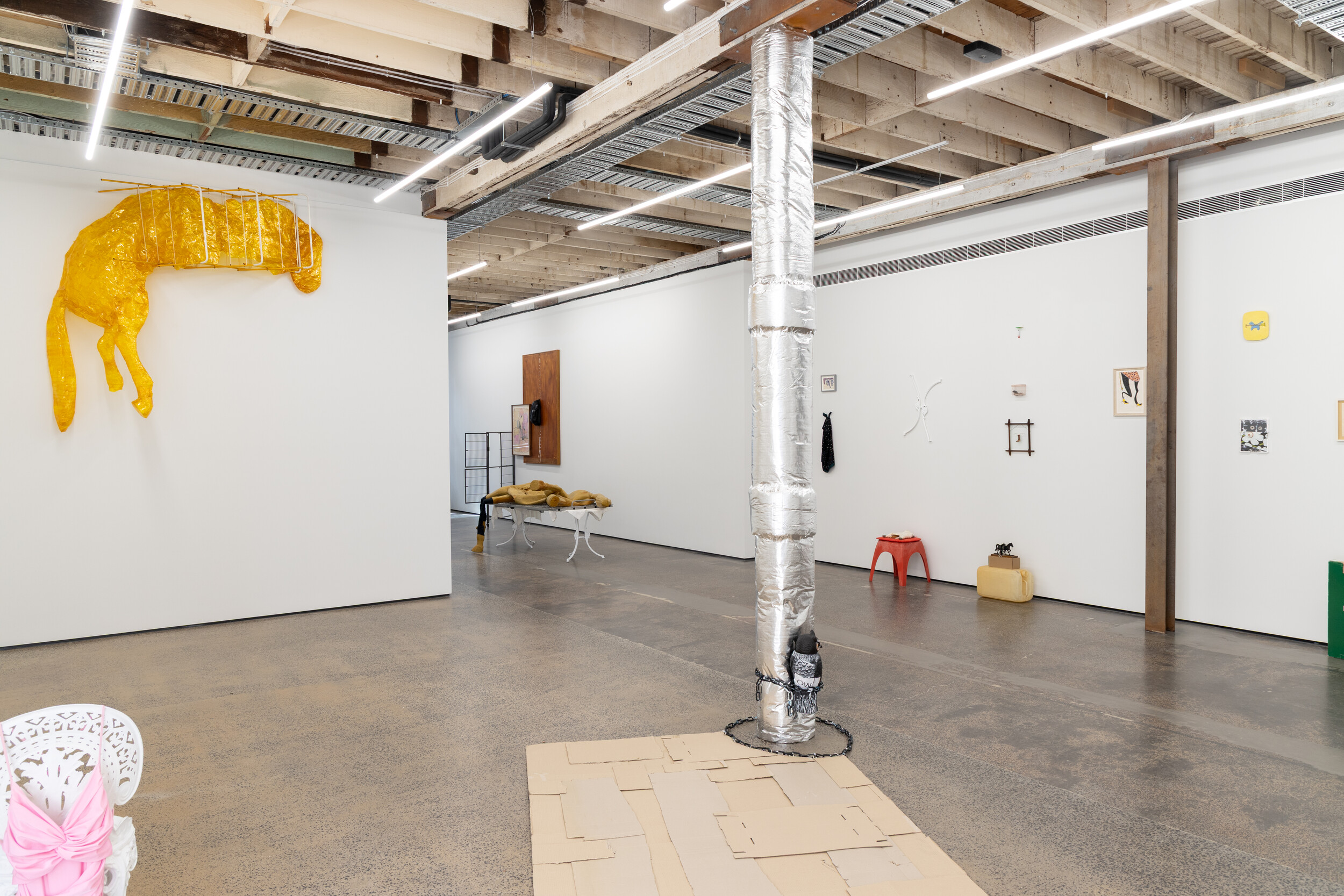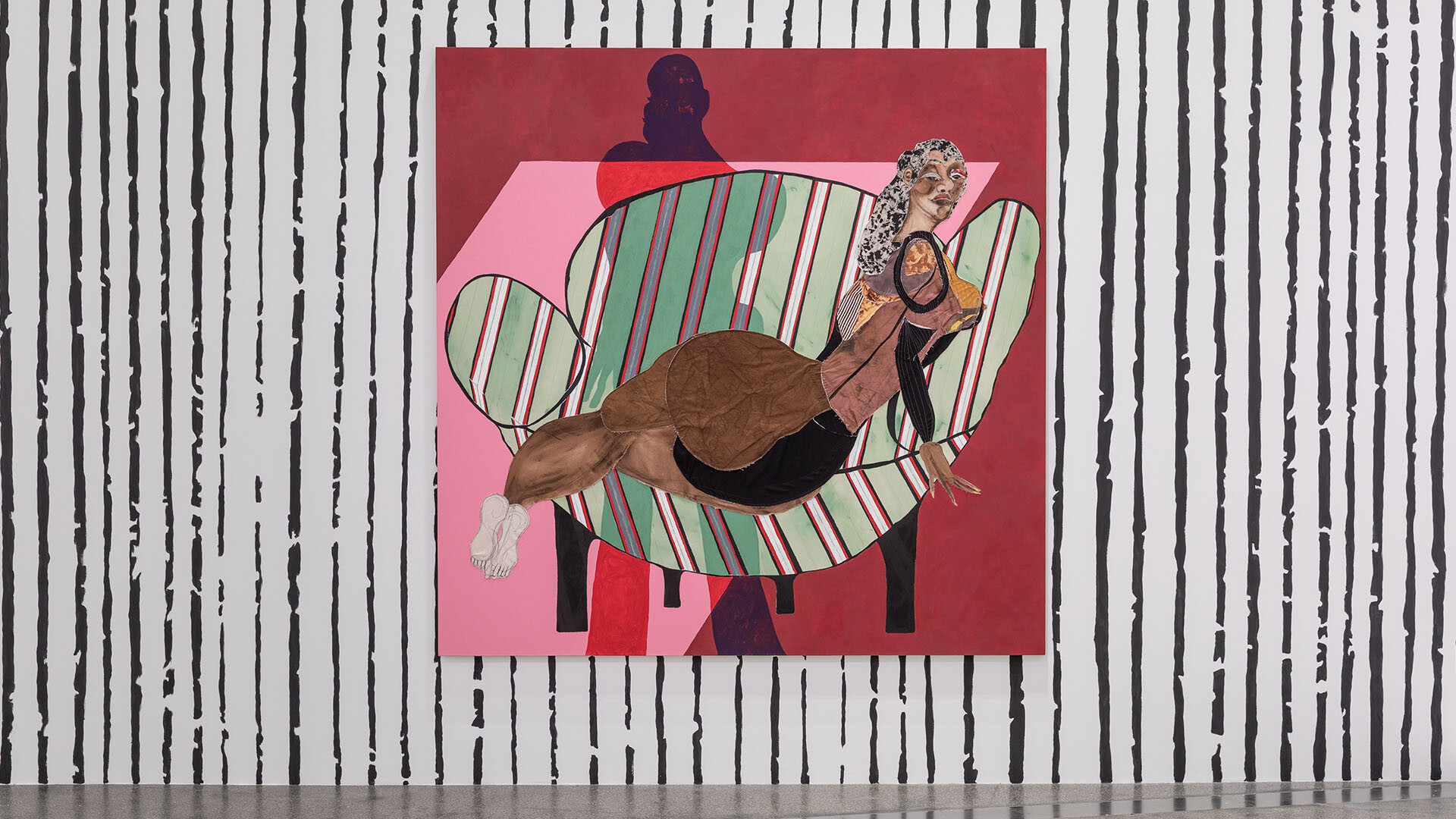Collection leads: John Scurry—small paintings
Marnie Edmiston
It's declared in the title—these are small paintings. Unframed, diminutive and brief sketches attached to mounting boards, they're physically bookended by two larger and more 'substantial' paintings. These works are ephemeral—painted in oil directly on cardboard, these images will deteriorate. We're told by the exhibition text that they were never intended for public viewing. Yet, amidst the advertised minority of the works it comprises, Collection leads: John Scurry—small paintings nonetheless manages to convey a feeling of a momentous and complicated nature. The larger paintings could be read as 'compensation'. But if we consider the works chronologically—Winter is from 1981, An Assembly from 2016, the 37 small paintings were completed between 2018–2019—we're put in an odd situation of reading these smaller paintings as the culmination of the artist's labour to date. On closer inspection, the works on show are nuanced and loose, evocative of an ambiguous atmosphere seemingly informed at once by the natural landscape and by the more intangible inflections of memory and imagination.
The 37 vignettes on show around the perimeter of the Geelong Gallery capture various states of decaying light and weather effects over open spaces of fields, beaches, plains, ranges, hills, lakes, rivers and grasslands. Appealingly vague in their definition, these snapshots, composed of the hazy interaction of colours, encourage a sustained viewing. Although the scenes are generally unpopulated and show sparse tracts of land or sea, the paintings don't allow the viewer full absorption in the image. Palette knife scratches, fingerprints and errant hairs disrupt the illusion, and the supports underneath also vie for the viewer's attention. The majority of these works have been completed on postcards: their plasticated surfaces maintain the paint's inherent slickness; a prophylactic separation preserves a minimal distance between medium and support, facilitating the murky interaction of tones and gradient blending constitutive of the all-over haze that sits between the landscapes and the apparent viewpoint. Remaining incongruously just above the surface, the paint's inconsistent application at times allows traces of the underneath images and text to float into view. Sometimes the frame of the images beneath shows through, as in Sultry (2018), or the translucency of the paint reveals marooned words—philosophy, letters—as in Dusk (2018). In Wintered (2018), indiscernible text striates the ground like so many wind-blown voices. These spectres, along with the scrapes and fingerprints, act as a reminder of the painted image's capacity as cicatrix—a visible trace, or seam—and marks a point of entry into an altogether different terrain.
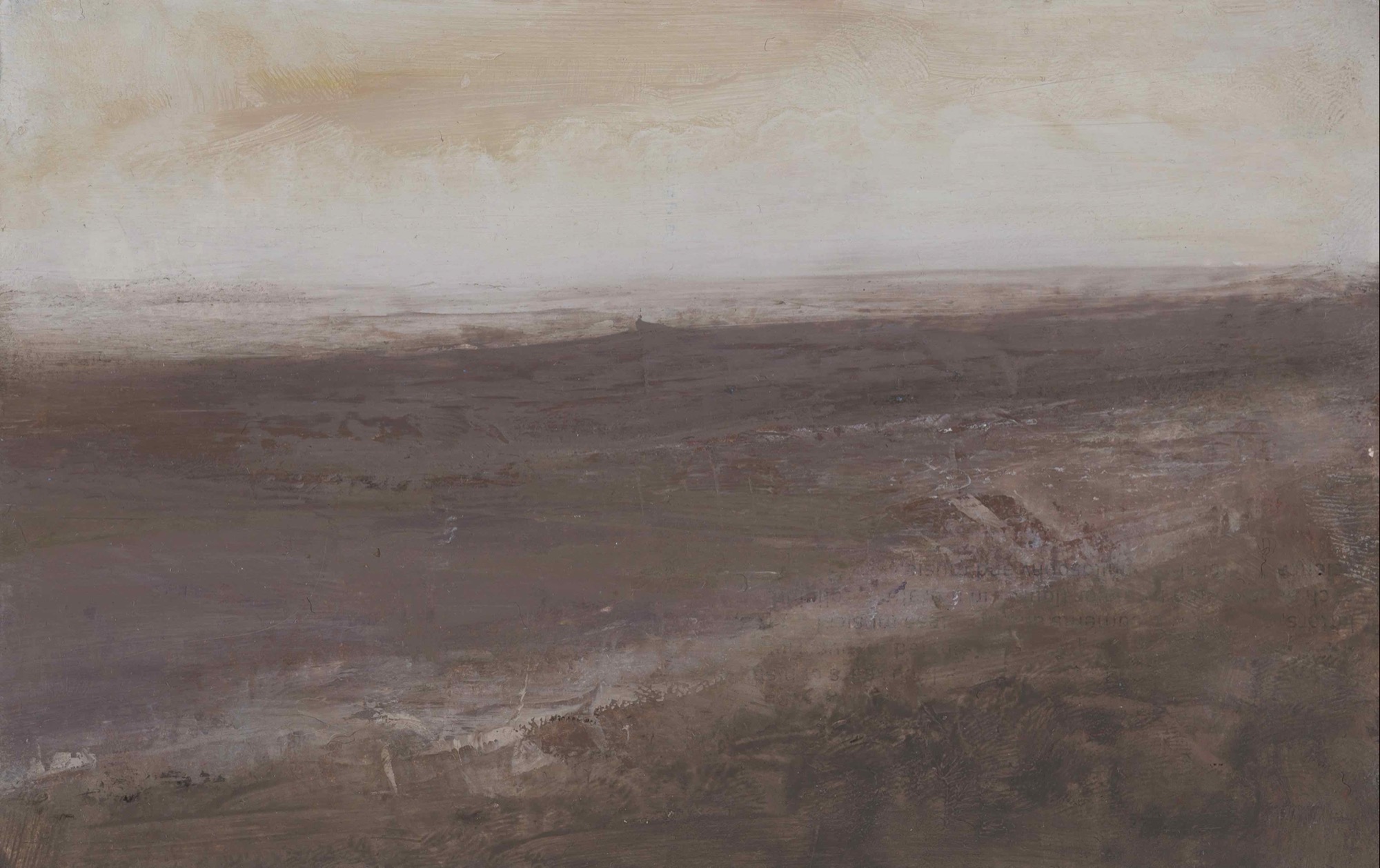
Begun as a private act of image making, the paintings curiously emerged from a situation wherein the 'real' work of the day had in a sense already been completed. In the exhibition text, Scurry lets the viewer in on his approach:
in the most prosaic sense they initially developed from the process of an end of day cleaning up of my palette to arrive at an unexpected accumulated dense tone of oil colour. The remains of the day as it were. (…) Somewhere in this process over subsequent paintings a more serious engagement took over, and an innate image-forming in the nature of an atmospheric landscape (as I experienced it) became the dominant direction in each work. (…T)he first foray or mark creates an imagined landscape of sorts…
In this mode of inward, intuitive response, without the need to plan from the perspective of an external viewer, a lucid image emerges capturing something in between a landscape, memory and fiction. This difference in style between the larger interiors on display and the smaller landscape sketches is stark; Winter and An Assembly are both completed with controlled brush strokes—their strongly individuated objects, although cryptically mute, sit readily available in the compositions. In the larger works one gets the impression of a scene being crafted in person, studied and recorded inside a hermetic studio. An Assembly, described in its didactic as a contemporary counterpoint to Winter, is positioned in direct opposition in the adjacent gallery space and placed amongst works by Australian modernist still-life luminaries Grace Cossington-Smith, Margaret Preston, Nora Heyson, Agnes Goodsir and Sybil Craig.
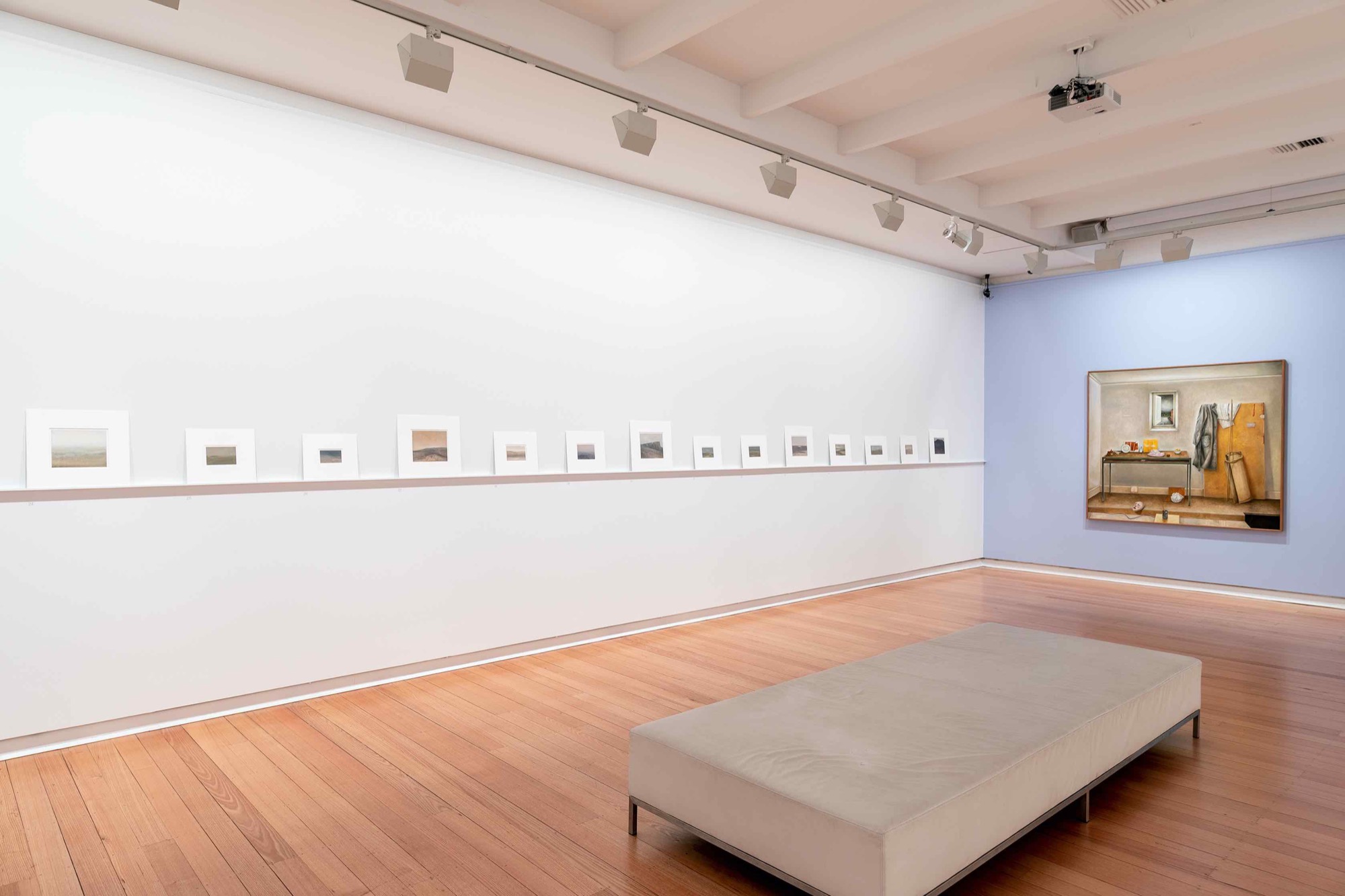
Though one can see in An Assembly the corners of a postcard hidden underneath a lemon, the sketches that comprise the exhibition are more closely linked to the small illustration that is pinned to the moveable wall in Winter. For the exhibition's curator Jason Smith, the 'exterior' scene shown through the painting's open window serves as the way into these smaller sketches, but we might rather attribute their genesis to this tiny note, depicting a city skyline in fog, 'winter' inscribed at the top. In Winter Scurry paints the framing of an impression; the interpretive mode that the work calls for is a kind of generation and decoding of the sense of links between objects. Rather than this more conceptually-regulated mode of viewing, the smaller works on display require a strenuous effort of creative-imaginative binding on the viewer's part and an attempt to hold the total composition together in order to extract a likeness of representation. Viewing these works through photographic documentation doesn't accurately replicate seeing them in person—the strokes within the paintings never seem to fully coalesce without the ability to step back from them in the space.
The sustained viewing that these paintings call for differs markedly from the postcard supports that they are completed on, which typically act as an index of a specific location—whether that be a landscape, touristic point of interest or artwork from a collection. The postcard's portability as index allows one to possess a mnemonic stand-in of the original, but very rarely is the reproduction capable of conveying the effects that comprise the surrounding atmosphere and imbue it with importance. In painting over these preexisting images Scurry is simultaneously cleaning his palette and the surface of the painting, keeping only those marks—those formal pre-investments—that sustain, in anticipation, the tone of the work. Scurry himself indicates in the exhibition text that these sketches reference the form of memory in general, rather than specific instances, and that they began as a kind of automatic, non-directed process of mark making and response. In painting over these postcards, Scurry leaves the viewer with an index in general of source image and memory.
It is in this capacity that these paintings have their most interesting relation to the imagistically saturated field of contemporary experience. They deliberately obscure their sources and bring attention to the unreliability of vision and memory at a time when these capacities are increasingly outsourced to the phone camera and cloud server. For Lyotard, the 'hardness of industrial beauty' inherent to photography is linked to the technology's capacity to 'mak(e) concrete the infinity of ideas', which he aligns with the state's tendency to 'identify with its infinite potential to generate data'. Scurry's works function in opposition to this impulse to catalogue, as the visual ambiguity in his paintings asks the viewer to draw on what Lyotard calls 'the faculty of feeling or of imagining…to make the perceptible represent the ineffable'. In Thames (2018), for instance, the moment in which one simultaneously sees a river, beach and swarm of fingerprints affords enough space to contemplate not just the strange resemblance between paint marks and landscapes, but also to register the creeping sensation that every landscape viewed from now on will be affected by this scene's memorialisation in paint.

Working with seriality and accumulation, these paintings are asking to be read as indices of particular scenes, and there's a parallel between the gradual accrual of paint and the stickiness of memories that amass, condense and change form over time. The private, inward nature of the work speaks to the distance between thoughts and their expression, and even the complicated way in which memories are sustained. These images also suggest that it is not just a landscape that can, through insistence, impose an impression. They also point us towards the lingering imprint of past artworks that are received directly or indirectly over time.
Scurry's paintings conjure apparitions of Turner and Whistler, two artists whose use of ambiguity captured the untamed force of nature and the eerily-calm fog of industrialisation. Take for instance Turner's Falls of Schaffhausen (Val d'Aosta) (c. 1845), acquired by the NGV in 1973. The majority of this picture is dominated by swirls of mist, while a scratchy outcropping extends from the bottom left of the frame. The ground doesn't quite anchor the disoriented viewpoint, and we're left wondering whether we're looking at the sky through the mist or its reflection in the water down below. Originally thought to be an alpine scene of the Val d'Aosta, it is a matter of contention whether this painting, and his other more abstract works like Sun Setting Over a Lake (c. 1845), were simply unfinished, or private studies in atmospheric effects. Scurry's own Alpine (2018) mimics this painting's ambiguity, with a darker patch of paint punctuated with blue and red streaks rising from the bottom left, overlooking an impenetrable bank of mist that could be either a coastline or mountain range.

Though of a similar composition to Falls of Schaffhausen, the calm pervading Scurry's work is visually closer to Turner's watercolours. An early notebook of Turner's, dated around 1815, has been reproduced in full in The 'Skies' Sketchbook. It was in this year that Mount Tambora in Indonesia 'erupted,' in the words of Turner scholar Martin Butlin, 'in the most spectacular and devastating volcanic explosion in recorded history, throwing a plume of dust and gas into the atmosphere. For almost three years, skies around the world went dark or developed a baleful, infernal glow as the sun or moon struggled to break through.' In many sketches, though, Turner's skies are an impossibly light and airy blue. Sequestered indoors and protected from the incessant storms, these sketches of a summer's sky are all the more evocative for having been embellished by the artist's memory and imbued with a sense of longing.
Influenced by Turner's visual studies into natural phenomena, Whistler looked instead to the effects of artificial light in urban nighttime. His series of Nocturnes were small studies of night landscapes and river scenes dotted with artificial light. Unable to paint in the moonlight, Whistler would go out into the Thames' fog, attempting to commit to memory the reflections of the sky, factories and lights in the water. In the morning he would set about painting from his recollection, using a thin mixture that would run across the surface of the canvas. The result, for instance in Nocturne: Grey and Silver (c. 1875), is a minimal film of paint that forms indistinct horizontal bands across the canvas, punctuated with a single tower and speck of lamplight.
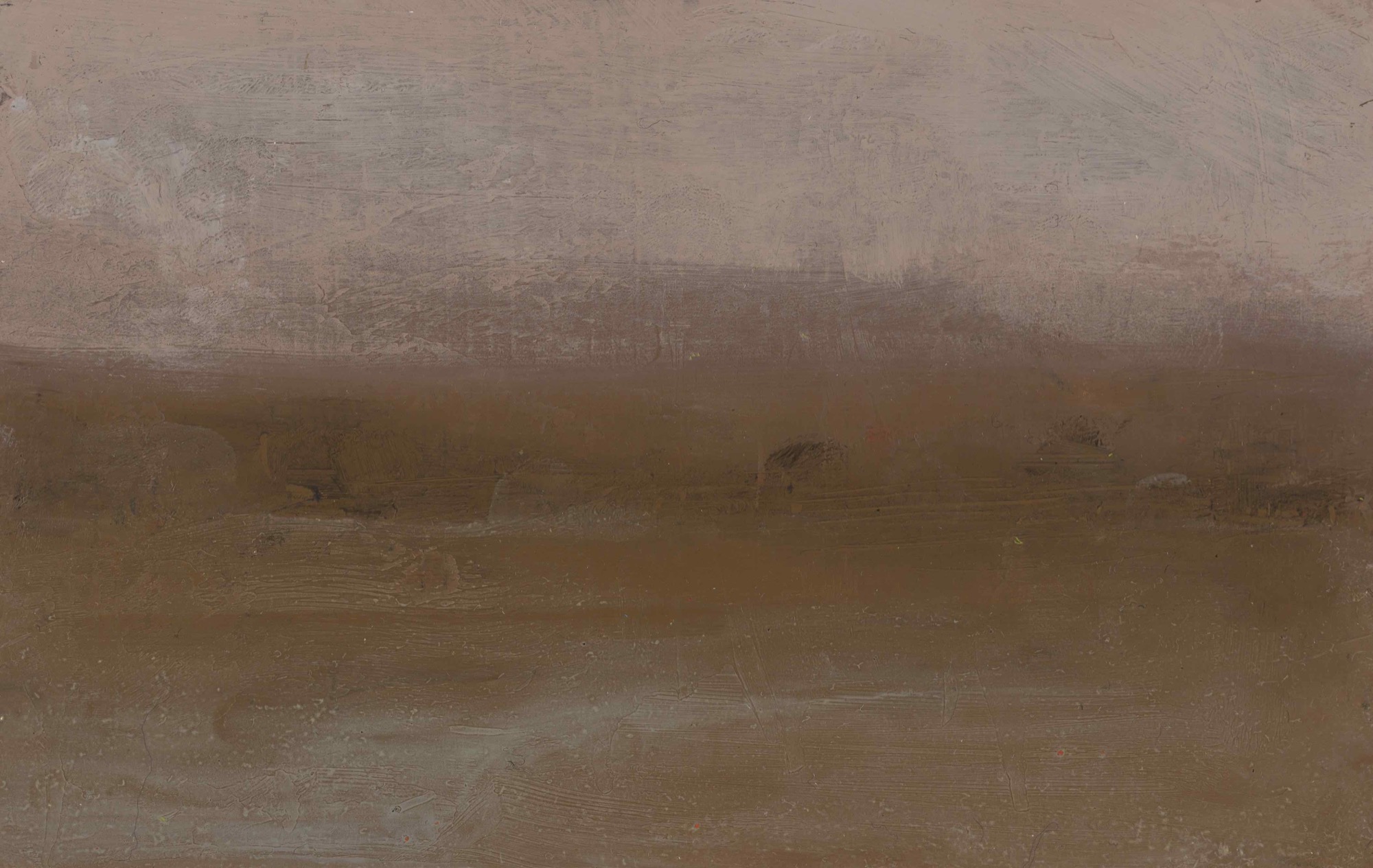
Although Whistler thought of these pictures as a formal exercise and used the London fog as a 'veil' that distanced the viewer from a narrative reading of the work, they also serve as mimetic documents of the industrial pollution enveloping London. In the light of day, the Thames was a frenzied barge route full of sediment and sewerage whose toxicity wiped out the marine animals that once inhabited the river. Similarly, the mist of London so beloved by Whistler was mostly carbon particles from the incessant burning of coal. This haze caused not only the surrounding trees and flowers to wilt, but inflicted the city's inhabitants with a wide array of respiratory diseases each winter.
Looking at Scurry's Cattle (2018) we could be forgiven for seeing in its enveloping russet-coloured cloud a nod to a Streeton-esque farming scene, such as Pastoral in yellow and grey: a colour impression of Templestowe (1889). The 'cattle' within Scurry's painting scarcely emerge out of this haze before receding again—the slightly darker finger smudges that comprise the animals' forms are almost imperceptible in the painting's photographic documentation—and it is unclear whether the viewpoint is actually 'on the land' or simply driving past. Rather than evoking an idyllic land of plenty, this grazing scene conjures ghostly apparitions of a mono-cultured, industrially cleared landscape.

This theme of destruction is seen more overtly in Aftermath (2018) where a fiery ochre and grey haze is interrupted on the far left by a rectangle of lighter paint that appears like a doorway or reflection. Apocalyptic in tone, the illuminated gateway verges on cliché but direct narratives applied to these scenes slide away when positioned amongst the serial repetition of the exhibition. A wryer take on extinction can be seen in Biblical (2018), where a bank of tempestuous clouds are shown travelling over open land. As we move left to right on the image, the paint's application gets thinner until finally, in the bottom right hand corner, it gives way to the blue ruled lines of a system card. In this instance, the 'human' impulse to read and record represented by the image's left-to-right propulsion and system card support is placed in uncomfortable proximity to the indomitability of nature.
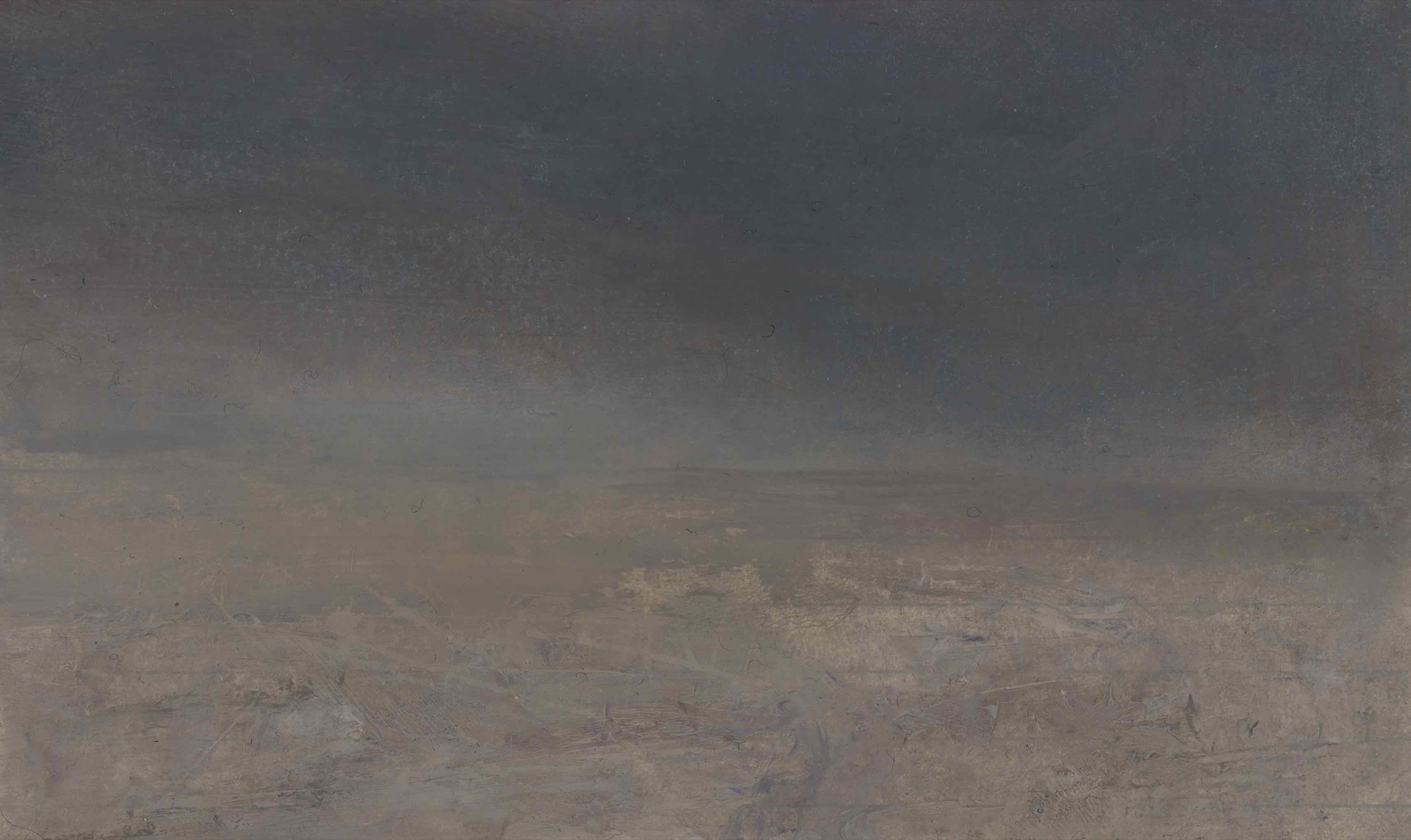
What is at play in these images, begun as solitary meditations but coalescing into coherence, is not so much remembering as reconstructing. Rather than explicit attempts by the artist to relive specific moments of his life, the works go beyond an individual conception of recollection. Scurry's quasi-automatic, serialistic paintings on postcard indices gesture towards the way that memory, as a cognitive function, requires active processes of forgetting to condense and change form according to their continually revised importance within the overall structure. In this process of forgetting, what was at one point important, and which is now no longer so, can be written over with another image. Scurry's 'non-directed' paintings betray his lifelong exposure to and consumption of art and draw into view historical resonances with, amongst others, Turner, Whistler and Streeton. These comparisons should not be misunderstood; instead of positioning Scurry's work as an attempt to vivify these precedents, his paintings instead draw our attention to the way in which modernity operates within and frames these images—a viewpoint of which would have been unavailable to contemporary viewers of these works. Turner's images of the wrath of nature, Whistler's poetic rendering of a polluted city and Streeton's romanticisation of golden pastures—all of these scenes are drawn into contemporary relevance by Scurry's questioning of the landscape genre.
Scurry enacts this questioning simply by painting a landscape now, in 2019, when we live on an earth seriously imperilled by modern artifice. His 'memorial' landscapes emphasise a certain naivety in these older artworks, highlighting how nature is approached as something raw and untouched, something separate from man and readily available for domination and subjugation. What Scurry's works reveal is that landscape painting as a genre exists only as an act of historical painting. His fragmented paintings make the landscape strange in their intimacy and internality; the works prompt us to recognise that we do not see nature when we look outside, but in Marx's phrase 'an historical nature and a natural history'. This is to say that Scurry's work makes clear that what we call nature is continuously forged and regulated by contemporary industry and modes of production, and that what we see as 'natural'—just as much as the patently 'artificial' field of aesthetic possibilities—is one point in a chain of influence. From this standpoint, Scurry's 'interior' landscapes register the contemporary, inwards-turning, subjugation of nature that is inherent within our data-centric experience.
Marnie Edmiston is an artist who lives in Melbourne. She received an MFA from Monash University in 2017.
